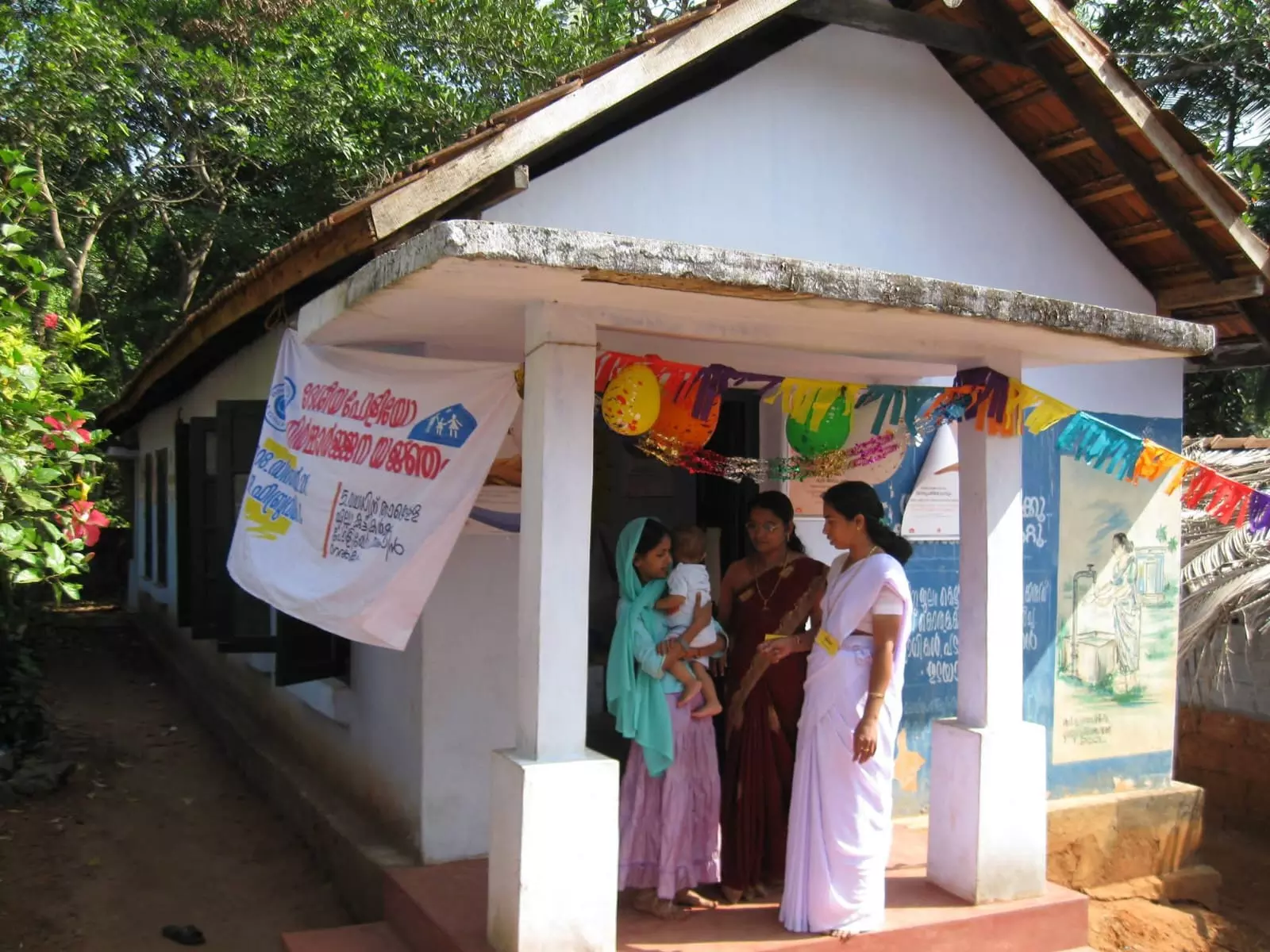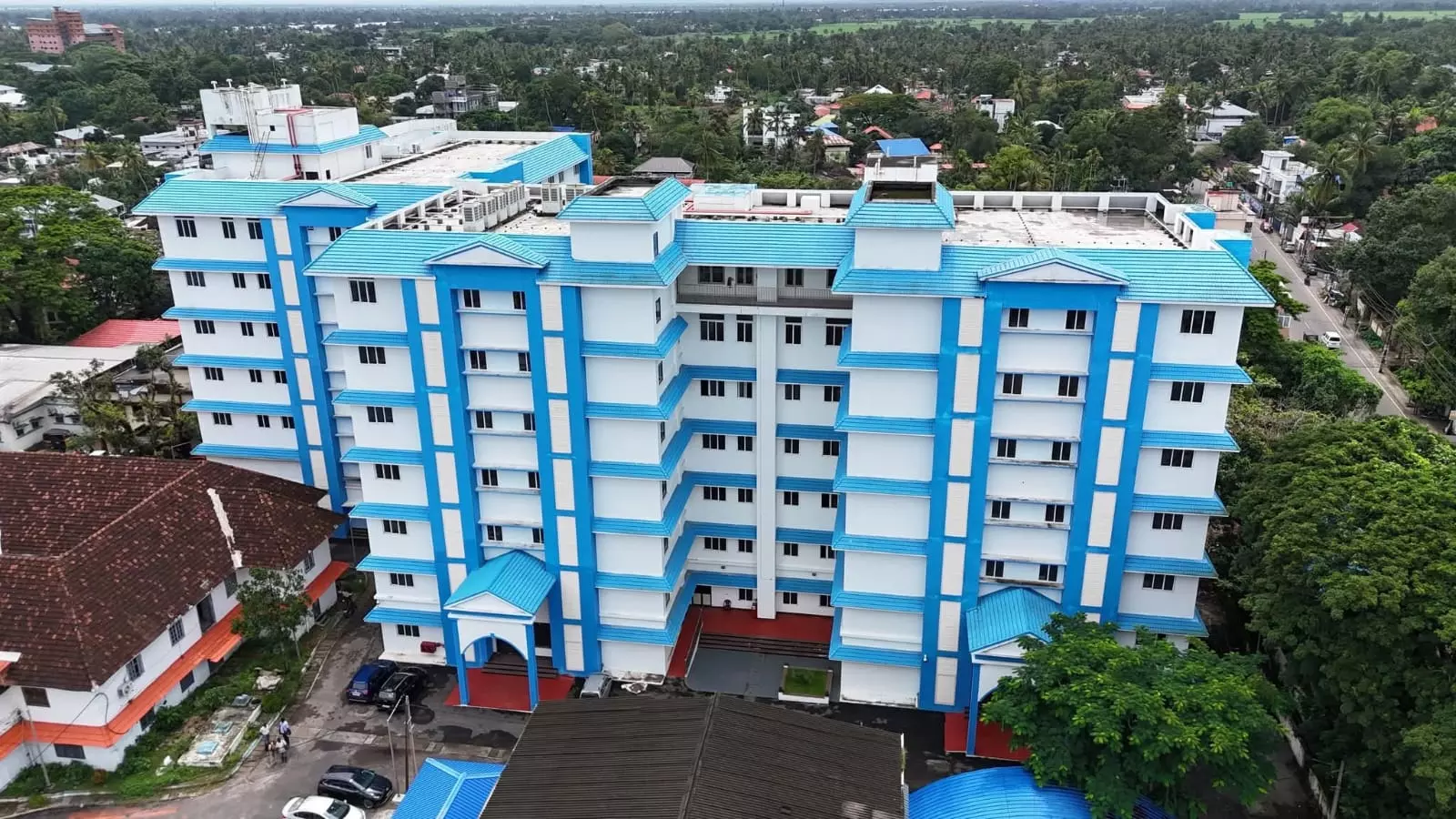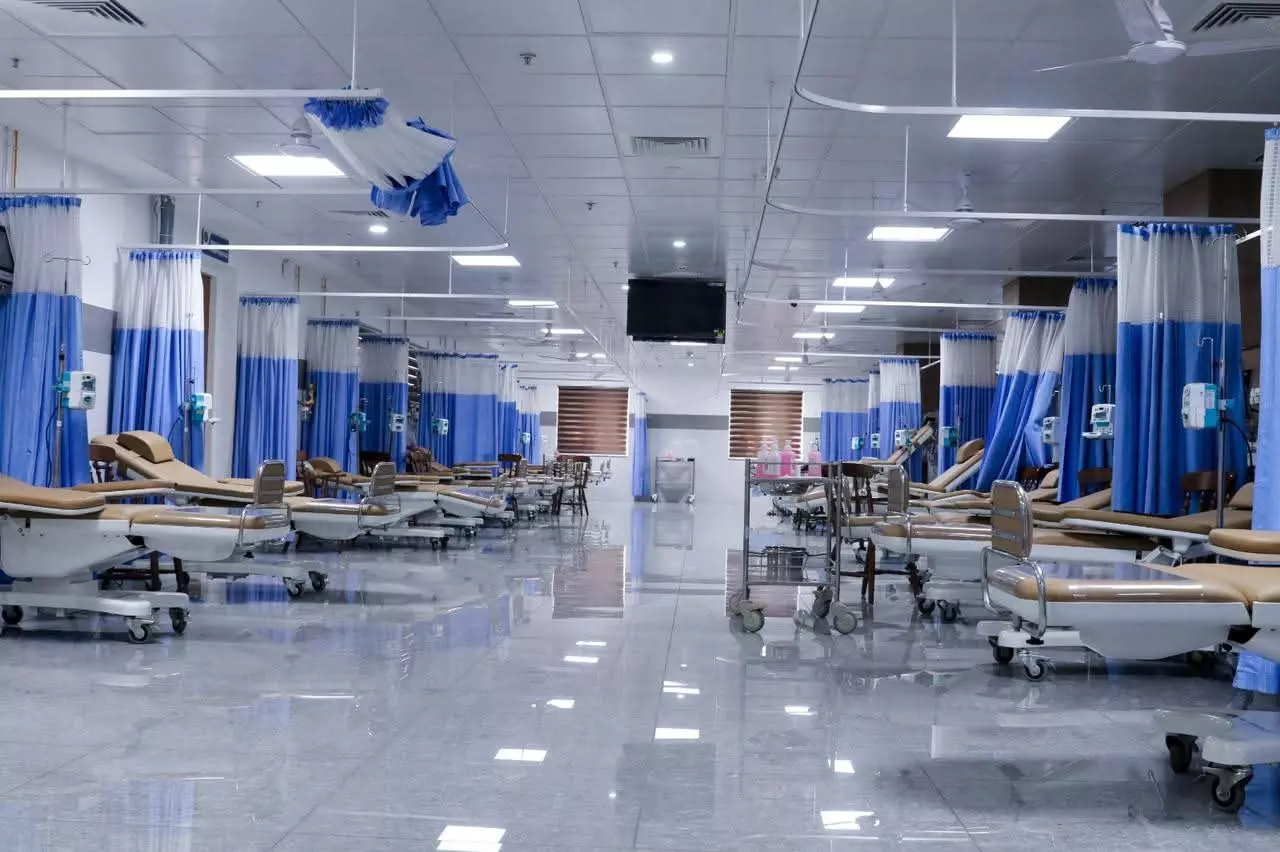
- Home
- India
- World
- Premium
- THE FEDERAL SPECIAL
- Analysis
- States
- Perspective
- Videos
- Sports
- Education
- Entertainment
- Elections
- Features
- Health
- Business
- Series
- In memoriam: Sheikh Mujibur Rahman
- Bishnoi's Men
- NEET TANGLE
- Economy Series
- Earth Day
- Kashmir’s Frozen Turbulence
- India@75
- The legend of Ramjanmabhoomi
- Liberalisation@30
- How to tame a dragon
- Celebrating biodiversity
- Farm Matters
- 50 days of solitude
- Bringing Migrants Home
- Budget 2020
- Jharkhand Votes
- The Federal Investigates
- The Federal Impact
- Vanishing Sand
- Gandhi @ 150
- Andhra Today
- Field report
- Operation Gulmarg
- Pandemic @1 Mn in India
- The Federal Year-End
- The Zero Year
- Science
- Brand studio
- Newsletter
- Elections 2024
- Events
Family clinics to swanky super speciality hospitals, the story of Kerala’s healthcare

Fifty-eight-year-old Ranjini, a retired teacher from Kochi is an eight-year cancer survivor. She underwent surgery for renal cell carcinoma in 2016 and has been on regular follow-up ever since. For the first five years, her review check-ups were scheduled every six months, later reduced to once a year at a super-specialty hospital in Kochi. Over time, she developed diabetes, which has since...
Fifty-eight-year-old Ranjini, a retired teacher from Kochi is an eight-year cancer survivor. She underwent surgery for renal cell carcinoma in 2016 and has been on regular follow-up ever since. For the first five years, her review check-ups were scheduled every six months, later reduced to once a year at a super-specialty hospital in Kochi. Over time, she developed diabetes, which has since led to complications like heart arrhythmia and a frozen shoulder. Now, each hospital visit — factoring in consultation fees, tests, and scans — costs her around ₹10,000.
“I have to go for a routine follow-up every six months after my surgery for renal cell carcinoma,” says Ranjini. “This includes either an ultrasound or an MRI scan — done alternately — along with a set of blood tests. The expenses have really gone up. Each specialist charges around ₹600 just for consultation. The blood tests alone cost me about ₹3,000, and an ultrasound adds another ₹3,000. If it’s an MRI that time, it can go up to ₹10,000. On top of that, I also need to consult an endocrinologist for my diabetes and an orthopaedic surgeon for my frozen shoulder. So, even without any treatment, just the review and monitoring itself comes to a hefty amount — it's become a real burden over the years.”

A rural family health centre
Ranjini was one of the fortunate few whose cancer was detected at Stage One — and that too at a small family clinic she and her father used to visit. It was run by an elderly doctor, now no longer alive, who first spotted the warning signs.
Also read | Wildlife Protection Act, 1972: A tale of conflict and controversy in Kerala
“Dr. Mohammed was more than just a doctor—he was a close friend of my father,” says Ranjini. “He had a small clinic near our home and continued seeing patients in the mornings even after his retirement, until he fell ill about five or six years ago and passed away within a few days. I had gone with my father to see him one day and casually mentioned some lower back pain. He took it seriously and suggested I get a scan, and that ended up revealing my cancer at an early stage.”
“He wasn’t a specialist—neither a urologist nor a nephrologist—just a general physician with a basic medical degree. His late wife was also a doctor. I remember her as the local ‘lady doctor’ who handled gynaecology and obstetrics in those days. She was the one who attended my mother when my younger brother, who’s fourteen years younger than me, was born.”
From small clinics to large multispecialty hospitals
Ranjini’s life story reflects a deeper shift that Kerala’s healthcare system has been undergoing rapidly in recent years — a transition from the familiar comfort of family clinics and neighbourhood doctors to the high-tech corridors of multispecialty hospitals, especially in the private sector.
Her cancer was first suspected by a long-trusted family physician — a general practitioner who had treated generations of her family in a small clinic near their home. That kind of long-term doctor-patient relationship, once common in Kerala, is now increasingly rare. The older model of care — where a single doctor knew the family’s medical history, offered personalised attention, and was accessible without layers of appointments — is slowly disappearing.

A Kerala public hospital. In 2004, only 47.4% of the population chose government hospitals for critical medical needs. By 2019, this number had jumped to 61.1%.
Today, most people, especially in urban and semi-urban areas, turn to large private hospitals and multispecialty centres for even basic health concerns. These institutions, while equipped with the latest technology and specialists in every department, often lack the familiarity and intimacy that once defined healthcare in Kerala. The shift is particularly evident in the private sector, where high consultation fees, segmented departments, and a growing dependence on diagnostic tests have become the norm.
“In earlier times, husband-wife clinics were quite common, but that trend has faded over the years,” notes Dr. Sulfi Noohu, national convener of the Indian Medical Association. “With the implementation of the Clinical Establishments Act in 2018—which mandates the registration and regulation of all clinics across recognised systems of medicine—operational costs for small clinics have gone up. These clinics often lack the financial capacity to invest in necessary infrastructure for diagnostic facilities or even basic comforts like proper waiting areas. As a result, patients increasingly prefer larger, well-equipped hospitals run by corporate entities, leading to the steady decline of small independent clinics.
Adding to this is the fact that Kerala produces more medical graduates than any other state, which further intensifies competition and reshapes the healthcare scene.
“People’s mindset is another factor contributing to the decline of local clinics,” says Dr. Joseph Chacko, a government hospital practitioner in Ernakulam district. “With the rise in migration and changing social dynamics, newly graduated doctors are no longer interested in setting up small clinics. Instead, they pursue higher salaries and better benefits in corporate or institutional settings. Many young doctors today also come from financially stable backgrounds, so opening a modest, local clinic is not an appealing option for them.”
“However, there’s room for optimism. With Kerala now home to 137 medical colleges, there is hope that the scenario may gradually shift, creating opportunities and perhaps even reviving interest in community-based practice,” he said.
Government hospitals over private ones
A comprehensive study on living conditions in Kerala, conducted over a 15-year period (2004–2019) by the Kerala Sasthra Sahithya Parishad, Kerala Padanam 2.0, reveals significant shifts in the state’s healthcare preferences and infrastructure. The data shows a marked increase in the number of people turning to modern medicine, with usage rising from 79.9% in 2004 to 87.6% by 2019. This upward trend in the use of allopathic treatment came at the cost of traditional systems like Ayurveda and Homeopathy, whose popularity declined in proportion.
Also read | Bharat Mata image sparks ideological clash, worsens governor-govt feud
What makes this trend particularly noteworthy is the parallel development observed in the public health sector. The study highlights a substantial rise in the number of people opting for government healthcare facilities, especially for the treatment of serious illnesses. In 2004, only 47.4% of the population chose government hospitals for critical medical needs. By 2019, this number had jumped to 61.1%.
This shift is indicative of two major changes over the period. Firstly, it reflects the tangible improvements made in Kerala’s public healthcare infrastructure and services—whether in terms of accessibility, quality, or affordability. Secondly, it underscores the rapidly escalating cost of treatment in the private medical sector, which appears to be pushing more people toward public hospitals. The rising financial burden of private healthcare has made government institutions not just a viable, but often a preferred choice, especially among the economically vulnerable sections of the population.
The study offers evidence of a growing public trust in government healthcare facilities in Kerala, alongside a broader transformation in how people engage with the health system—moving away from traditional systems and private services, and toward a more state-supported model of care.
"Government healthcare facilities have expanded significantly, prompting people to choose them over smaller clinics that lack adequate infrastructure," says Dr. K.P. Aravindan, senior pathologist and one of the lead figures behind the study. "Government hospitals today offer better buildings, advanced equipment, and improved services—including access to dialysis centres. Between 2004 and 2019, these institutions recorded a 41% growth rate, which clearly reflects the rising public preference for government healthcare."
The other side
There is, however, another side to this seemingly positive picture. While government healthcare has expanded, the private sector continues to dominate in the area of super-specialty treatments. The government is struggling to keep pace in this highly competitive space, which demands massive investments in cutting-edge technology, advanced medical equipment, and modern infrastructure—areas where the private sector has a clear advantage.
“Corporate hospitals have become even bigger through the flow of foreign money. About 70%-80% shares of huge private hospitals in big cities are now owned by bigger corporations. Their intention is to build a medical tourism market which will attract people from the gulf or other countries to seek cheaper healthcare services. This will lead to the lower class seeking cheaper healthcare. Old missionary hospitals like Lissie and Lourde at Kochi can provide for those in need,” adds Dr. Aravindan.
This is one area where small private clinics—alongside the government network of primary health centres, community health centres, and family health centres—could play a crucial role. However, their very survival is under threat in Kerala, caught between the rising dominance of corporate hospitals and the shifting healthcare preferences of the population.
“The concept of having a family doctor which is yet to be implemented in India is very important as it will help the old aged in seeking treatment. Before consulting a specialist, it is important to consult a general physician who can diagnose and treat a patient with medication before jumping into surgeries,” feels Dr Joseph Chacko.
“The difference of having a family doctor and a regular physician is that, the family physician will know your whole family’s history and will be able to diagnose you more easily with the information the doctor already has about you and your family’s health. The humanitarian consideration is also much stronger for a family doctor than of a regular doctor. Sometimes patients are the ones who demand surgical procedures instead of medical treatments which a family doctor can make their patient understand their condition much better,” adds Dr. Chacko.
“Unnecessary procedures and surgeries can be avoided. There is also a grey area where both medical treatment and surgical treatments are done by these big corporate hospitals. Having a family physician will avoid this,” Dr Sulfi Nuhu seconds these thoughts.
The spread of corporate hospitals
According to Dr. K.P. Aravindan, corporate hospitals have expanded their presence beyond major cities into smaller towns as well. With an increasing demand for procedures like angioplasty and bypass surgeries—services that small family clinics are unable to offer—people are naturally turning to larger corporate hospitals. These facilities not only provide advanced treatments but also offer better staff services and a sense of social mobility that appeals to those climbing the social ladder. As a result, the demand for smaller clinics has declined, making it increasingly difficult for them to remain economically viable.

The rising financial burden of private healthcare has made government institutions not just a viable, but often a preferred choice.
Doctors like K.P. Aravindan, who work closely with people’s science networks, believe that small clinics and family-run hospitals could still be sustained if the government offers basic support—such as subsidised electricity and water. There have been suggestions to formally integrate these smaller institutions into the broader public healthcare system.
“Such integration could take place through a strengthened referral system, where secondary-level hospitals receive cases from lower-tier facilities, creating a more cohesive and efficient network. This referral-based model, widely used in many countries, could significantly enhance the functioning of Kerala’s healthcare system.”
Dr. Aravindan also emphasizes the urgent need to increase the number of doctors trained in family medicine, to better serve communities at the primary level and ensure continuity of care.
Even though Kerala's public sector has made significant strides in primary and community healthcare over the past two decades—through improvements in infrastructure, service delivery, and accessibility—the concept of a structured, multi-tiered treatment system has still not taken firm root in the state.
Ideally, a well-functioning healthcare model would operate on a referral-based hierarchy: patients first approach primary care centres, and are then referred to secondary or tertiary care based on need. However, in practice, this laddered approach is often bypassed. The growing allure of super-specialty care—amplified by the aggressive marketing of corporate hospitals—has led many people, especially those with financial means or health insurance, to skip the initial levels of care altogether.
Instead of consulting a local family physician or visiting a primary health centre, patients often head directly to specialists and super-specialty hospitals, even for ailments that could be managed at lower levels. This not only increases the cost burden on individuals and families but also overloads higher-tier hospitals with cases that do not necessarily require their level of expertise.
This bypassing of the primary and secondary tiers undermines the efficiency of the public healthcare system and weakens its foundational principle of equitable access. It also widens the gap between those who can afford premium care and those who rely solely on public services, making the system increasingly fragmented.
“One of the major challenges in our healthcare system is the inability to maintain a proper referral structure,” says Dr. A.K. Jyasree, Professor and Head of the Department of Community Medicine at Government Medical College, Kannur. “We've gradually shifted to a culture where people directly approach specialists and super-specialists for even minor health issues. This not only burdens the healthcare system but leads to overcrowding in both public and private hospitals. Just yesterday, I received a consultation request from a friend who has been simultaneously visiting a dermatologist, a gynecologist, and a psychiatrist. The medications prescribed by each of them were actually conflicting with one another. This is exactly where the concept of a family doctor becomes vital—someone who can provide coordinated, comprehensive care and guide patients through the appropriate treatment pathways.”
Kerala’s road to reforms
It will be interesting to have a look at another 2023 study on Kerala’s primary healthcare reforms which highlights the early impacts of the state’s “Aardram” initiative, launched to strengthen the public health system and move toward Universal Health Coverage. The reforms, which began in 2017, involved upgrading selected Primary Health Centres into Family Health Centres by enhancing staffing, extending working hours, and expanding service offerings. Though key health coverage indicators—like full antenatal care and immunization—showed little difference between FHCs and PHCs, the study found notable improvements in service delivery at FHCs.
On average, FHCs had a slightly higher number of medical officers (0.8 per 10,000 people) and more than double the staff nurses compared to PHCs (less than 0.4 per 10,000). FHCs also recorded significantly higher outpatient visits and offered additional services such as screening for depression and chronic lung diseases. The study concludes that Aardram’s primary care reforms show promising early results, but their uneven implementation calls for sustained monitoring and course corrections to ensure broader and more equitable health gains across Kerala.
Many healthcare professionals and public health activists believe that this is precisely where a decentralized treatment structure—whether through private or public sector clinics—can make a significant difference. By strengthening local-level clinics and ensuring accessible, community-based care, the healthcare system can become more efficient, equitable, and responsive to people's needs. These decentralized setups can serve as the first point of contact, offering timely treatment, reducing unnecessary pressure on super-specialty hospitals, and reinforcing the referral-based model that Kerala’s health system aspires to implement effectively.
